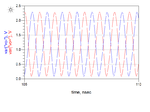plevrakis
Newbie level 1

Hello, i have designed an Nmos cross coupled lc oscillator at 1.5 GHz in ADS (using Vdd=1.2V, non ideal L=3.4nH ,non ideal C=3.3nH ,NMOS BSIM4 65nm with W=10u,I_BIAS=4mA)..when i am trying to use varactors to see the tunning bandwidth, i get messages for no convergence, loop gain too low to start oscillations etc(an I_BIAS has increased to 14mA)..can anyone help me? thank you in advance





